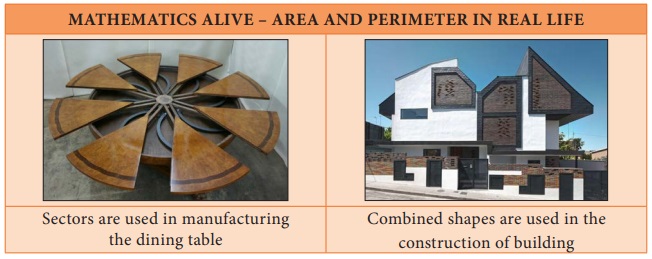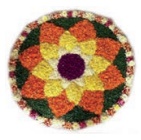Chapter 2 | 8th Maths - Measurements | 8th Maths : Chapter 2 : Measurements
Chapter: 8th Maths : Chapter 2 : Measurements
Measurements
MEASUREMENTS

Learning Objectives
• To know
the parts of a circle.
• To calculate
the length of arc, area and circumference of a sector.
• To calculate
the area and the perimeter of combined plane figures.
• To understand
the representation of 3-D shapes in 2-D.
• To understand
the representation of 3-D objects with cubes.
Introduction
An important
aspect in everyone’s day-to-day life is ‘to
measure’. Measuring the length of a rope, the distance between two places, finding
the perimeter and area of plots and lands, building the structures under specified
measures etc., are a few of the many situations where the concept of ‘measure’ is
used.
It is said
that the biggest invention by man is the wheel.
The wheel is otherwise called as the ‘cradle
of invention’. What is the shape of a wheel? Circle, isn’t it? In the things
we use, apart from circles, we can also see different shapes like triangles, squares,
rectangles etc.,
Measurements
play a vital role in everyone’s life. Not only the persons who learns proper mathematics
in schools, but also the layman uses his logical thinking to apply the concept of
measurements when he needs. For example, a carpenter who carves out the wooden wheels
of a temple car wants to protect the outer surface by an iron strap. With all his
experience, he says that a 22 feet strap will be required for a 7 feet high (diameter)
wooden wheel.
MATHEMATICS ALIVE –
AREA AND PERIMETER IN REAL LIFE

We have already
learnt how to find the perimeter and the area of shapes like circles, triangles,
squares, rectangles, trapeziums, parallelograms etc. In this chapter, we shall see
the parts of a circle and how to find the perimeter and the area of a sector and
some combined shapes.
Recap
The teacher
asks the students to calculate the area of the circle of radius 7 cm. Many students have solved it as in Method
1, but a few of them have done it as in Method 2.

Then, they
had the following conversation:
Sudha : Which
of these two answers is correct, Teacher ?
Teacher :
Both answers are correct but only approximate
Sudha : We
get two answers for the same question. How is it possible, teacher?
Teacher :
We can infact solve this exactly as π×7×7= 49π sq.cm.
Meena : When we find the area of a square, a rectangle
etc., we all get unique answers but why is the area of a circle not unique ?
Teacher :
What is the value of π ?
Meena : The
value of π is 22/7 or 3.14
Teacher
: Actually it is neither 22/7 nor 3.14. They are only approximate values.
Meena : Then,
what is the exact value of π?
Teacher :
Though π is the constant, it is a non-terminating and non-recurring decimal number.
So, we are not able to use its exact value and to make the calculations easy, 22/7
or 3.14 is used as the approximate value of π.
Meena : Is the area of a circle always approximate,
teacher?
Teacher :
No, it is an exact answer unless we substitute the value of π as 22/7 or 3.14.
Meena : Then,
for the above problem, 49π sq.cm is an
exact answer whereas 154 sq.cm and 153.86
sq.cm. are approximate answers. Am I right,
teacher?
Teacher :
Yes, you are right Meena.
Think
1. 22/7 and 3.14 are rational numbers. Is ‘π’ a rational number?
Why?
Solution:
22/7 and 3.14 are rational numbers π has non−terminating and non−repoating
decimal expansion. So it is not a rational number. It is an irrational number.
2. When is the ‘ π ’ day celebrated? Why?
Solution:
March 14th is the π day celebrated for
every year. Approximately value of ‘π’ is 3.14.
The circumference of a circle is 2πr units, which can also be written
as πd units. As π =3.14 (approximately) and it is slightly more than 3, for some
quick guess, we shall say that a circle whose diameter is d units shall have its circumference slightly more than three times
its diameter.
For example,
If a round table of diameter of 3m is to be decorated by flower strings around it, it will require a
little more than 9m of flower strings.

Related Topics